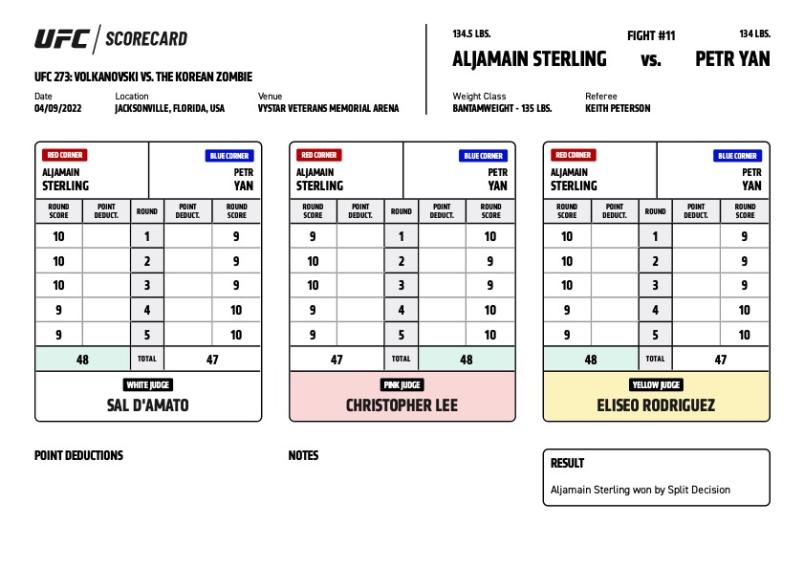Have you recently watched a UFC event and heard people complaining about a judge’s scoring? Are you wondering about how UFC fights are scored?
Let’s take a look.
Contents
- How Are UFC Fights Scored? (UFC Scoring System)
- How Are Fighters Judged? (UFC Judging Criteria)
- How is Effectiveness Judged?
- How Are UFC Rounds Scored?
- What Are the Possible UFC Fight Decisions Based on the Judge’s Scorecards?
- How Do Illegal Strikes Affect UFC Scoring?
- Is UFC or MMA Scoring Subjective?
- What Are Some Controversial UFC Fight Scores?
- The Bottom Line
How Are UFC Fights Scored? (UFC Scoring System)
The UFC uses the 10 Point Must Scoring System, and it’s the standard of judging criteria as set by the Official Rules of MMA.
Under this system, 10 points must be given to the fighter who wins the round, and nine points or less to the loser. This means it’s possible for a fighter to win a round by scoring 10-9, 10-8, and even 10-7.
10-10 scores are an exception to the rule, but they’re extremely rare. The most common rounds are 10-9, given to the fighter who wins by the slightest margin.
There are a minimum of three judges, and a minimum of three rounds, to be scored separately at the end of the round.
The scores of each round are tallied and revealed if required for an early decision result, or if the fight reaches the end of the last round without there being a winner.
How Are Fighters Judged? (UFC Judging Criteria)
Under the 10 Point Must System, there are three ways fighters are judged:
Plan A: Effective striking and grappling – judging rewards the greater impact and effect of legal strikes landed (quality over quantity).
Plan B: Effective aggressiveness – judging rewards the more offensive fighter who makes more attempts to push forward and attack or finish the fight.
Plan C: Control of the fighting area – judging rewards octagon control (center of the ring), pace dictating, and position of the fight, such as pushing the opponent to the cage.
Note: Plan B and C are only considered if Plan A is judged to have been even and inseparable. However, the overwhelming majority of rounds are separated by effective striking and grappling.
How is Effectiveness Judged?
Not only do judges have to evaluate based on the three-plan system, but they also have judging criteria in relation to this system, which determine how rounds should be scored.
In particular, they judge:
Impact – Impact from strikes, such as visible damage, and any impact that affects a fighter’s body language, energy, and control.
Dominance – Dominant striking is where high amounts of strikes are landed on an opponent who is continually defending and not returning strikes. Dominant grappling is where a fighter takes aggressive positions over their opponent and attempts to end the fight through landing strikes and/or submissions.
Duration – The time a fighter spends impacting and dominating their opponent through effective offense.
Scoring of incomplete rounds – Judged on what little fighting there may have been. This promotes fighters to be offensive at all times. Point deductions are applicable here.
How Are UFC Rounds Scored?
As stated in the introduction, each round of a fight can be scored ranging from 10-10 to 10-7, in favor of one fighter.
Here’s how they’re awarded:
10-10 round – An extremely rare score, given when there’s no advantage to any fighter. However, if fighters are equal on striking/grappling, they’re never equal on both aggressiveness and octagon control. They mostly exist for uncontested rounds that have to be scored when awarding a technical decision.
10-9 round – The most common score given to the fighter that wins by a close margin. Even if the strikes landed and grappling are extremely close, one fighter will be awarded the round based on aggressiveness or octagon control.
10-8 round – An Uncommon score. A fighter has to win by a large difference as judged by impact, dominance, and duration. Judges normally have to see a knockdown or takedown, one-way traffic in strikes landed, and the effectiveness of strikes.
10-7 round – The rarest score. A fighter has to completely overwhelm their opponent based on impact, dominance, and duration. It would see a fighter close to being knocked out or submitted and punished for the full 5 minutes. Even then, fighters who are overwhelmed usually don’t make it through the round.
Other Scores – The above scores are given based on the 10 Point Must System, but there can be rounds where neither fighter gets 10 points because of point deductions (1 or 2).

What Are the Possible UFC Fight Decisions Based on the Judge’s Scorecards?
The scores of all three judges are tallied and revealed by the cage announcer. Here are the possible decisions:
Unanimous Decision – All three judges scored the win for the same fighter. Individual round scores are totaled and the winner has more. For example, if a fighter wins two rounds out of three, they will win 29-28.
Split Decision – Two judges scored the win for one fighter, and one judge scored the win for the other fighter.
Majority Decision – Two judges scored the win for one fighter, and one judge scored the fight as a draw.
Technical Decision – If a fight is stopped past halfway through the scheduled rounds due to an accidental foul, the judge’s scorecards will be used to decide the winner.
Unanimous Draw – All three judges score the fight as a draw.
Majority Draw – Two out of three judges score the fight as a draw.
Split Draw – All three judges score the fight differently but the score totals all result in a draw.
Technical Draw – If an injured fighter cannot continue because of an early intentional foul, the fight results in a technical draw if they’re behind or drawing on the scores (must be stopped past halfway through the scheduled rounds).
How Do Illegal Strikes Affect UFC Scoring?
Illegal strikes affect UFC scoring greatly as they lead to one or two-point deductions for the guilty fighter, and may even eliminate the use of scorecards altogether.
With one point being the most common deduction, a fighter’s chance of winning is much lower, especially in a three-round fight. In that case, they would need to win all three rounds by a score of at least 10-9 to win the fight, as winning two out of three rounds (10-9 each round) would result in a 28-28 draw.
If an illegal strike is deemed intentional and a fighter is unable to continue, the fight ends in disqualification and the scoring is no longer used.
Accidental illegal strikes that prematurely end the fight before halfway through the scheduled rounds result in a no contest or disqualification. Whereas if they end the fight past halfway through the scheduled rounds, a technical decision is awarded to the fighter who is ahead on the scorecards.
Before a technical decision is awarded, point deductions are applied to the scorecards and partial or incomplete rounds are scored, with even rounds scored as 10-10 (mostly given to rounds that haven’t started).
How Does the Referee Decide Point Deductions?
2-point deductions are a rarity because they only occur when an intentional illegal strike causes an injury that may affect a fighter’s ability to continue, and this can be viewed differently by each referee.
The best example here would be an intentional illegal knee to the head of a downed opponent, resulting in an injury that isn’t extreme enough to end the bout. If the fight continues, 2 points should be deducted from the offender.
1-point deductions are usually taken for illegal strikes deemed unintentional, or for illegal fouls deemed intentional.
Referees will usually issue a warning for a first-time illegal strike, followed by a one-point deduction for repeat offenses.
Intentional illegal fouls may follow the warning and point deduction pattern, depending on the referee. An example of an intentional illegal foul may be grabbing the fence to avoid being taken down.
Is UFC or MMA Scoring Subjective?
The judges follow the UFC judging criteria as best they can, but fights are seen differently by different judges. There is also an element of agreed-upon, unwritten rules.
Knockdowns (from striking) are judged highly as they are impactful, dominant, and usually lead to a long duration of offense.
Takedowns are also judged highly, but not as high as knockdowns (unwritten rule). Meaning that if fighter A scored a knockdown and fighter B scored a takedown, and they both landed similarly effective damage; fighter A would take the round 10-9.
This is because the impact that knockdowns have on a fighter tends to be much higher than a takedown. Takedowns in the UFC often cause little impact and result in nothing more than a stagnant top position (ineffective).
However, takedowns are judged highly because they can be impactful and lead to a lot of dominance and duration on the ground. They allow for offensive positioning, many unanswered strikes landed, submission attempts, and control time.
Furthermore, a huge difference in the number of strikes landed between two fighters gives the round to the fighter who lands more. Despite strikes and grappling being given equal weight according to the rules, only a takedown will give the fighter who has been massively outstruck a chance at winning the round.
Lastly, many believe 10-9 rounds are given too easily and there should be more 10-10 rounds. However, the common scoring of 10-10 rounds would make judges lazy as they could avoid focusing on the fight or become hesitant to put their necks on the line.
Also, the common awarding of 10-9 rounds for the slightest differences promotes fighters to be offensive throughout.
What Judging Biases Come Into UFC Scoring?
Along with the subjectivity in the way effectiveness is viewed, there are also biases that may sway a judge to vote one way or another; especially when 10-9 rounds are decided by the closest of margins.
Here’s a list of potential swaying factors in a close fight:
Home ground bias – The fighter on home soil has the support of the crowd and is therefore viewed more positively.
Champion bias – For the champion as there’s an aura around them and an unwritten rule that challengers have to do more to take the belt.
Legend bias – The fighter has a name and a long career in the UFC and is therefore viewed more favorably.
Visible damage bias – Too much emphasis can be put on visible blood, which doesn’t always demonstrate effective strikes but more so on how some fighters are more genetically predisposed to bleed than others.
What Are Some Controversial UFC Fight Scores?
Let’s look at three examples:
Andrei Arlovski vs Jake Collier (UFC Vegas 53)
One judge scored it 3-0 to Collier and two judges scored 29-28 in favor of Arlovski.
Collier landed 27 more strikes (2 more significant) and scored 2 takedowns compared to 0 for Arlovski. All media judges on MMA decisions scored the bout in favor of Collier.
The only reason the two ringside judges could have scored in favor of Arlovski is that Collier looked more impacted due to visible bleeding. However, as the significant strikes in rounds 2 and 3 were very close, judges have to consider the takedowns from Collier.
If this wasn’t enough for the win, the constant forward pressure by Jake should have seen him awarded the win.
Shogun Rua vs Lyota Machida (UFC 104)
All three judges scored the fight 48-47 for defending champion, Machida.
Total strikes were 82 for Rua and 39 for Machida, which saw Rua ahead in every round in a fight having no knockdowns. All media judges on MMA Decisions voted in favor of Rua.
There were no takedowns for either fighter, but Rua attempted 4 takedowns. These takedowns led to dominant clinch positions, on top of the aggressive forward pressure throughout the fight by Rua.
The judging of this fight was inexcusable and the only reason the judges scored the bout in favor of Machida is because of champions bias and the fact Machida was on a 15-fight win streak.
It’s also said the judges were awestruck by Machida’s karate fighting style.
Michael Bisping vs Matt Hamill (UFC 75)
One judged score 30-27 for Hamill, while the other two judges scored 29-28 for Bisping.
Hamill had more strikes, 88 to 65, as well as more takedowns, 6/12 compared to Bisping’s 0 (takedowns were scored in all three rounds). These takedowns led to effective ground and pound from Hamill.
Hamill was also dominant in the clinch and pushed the pace of the fight throughout. The judging here was extremely poor and can be put down to home favor since Bisping was fighting in England.
The Bottom Line
Dana White famously said, “never leave a fight in the hands of the judges”, perfectly summarizing the imperfection of the current UFC scoring system.
Despite detailed objective criteria for aiding judges on what to look for, determining the winner of a fight is always subjective. Adding to this, many UFC fights have extremely close rounds, and awarding a 10-9 can go either way.
On top of this, sometimes the judges get it plain wrong, therefore UFC scoring will always have questionable results and scorecards.




